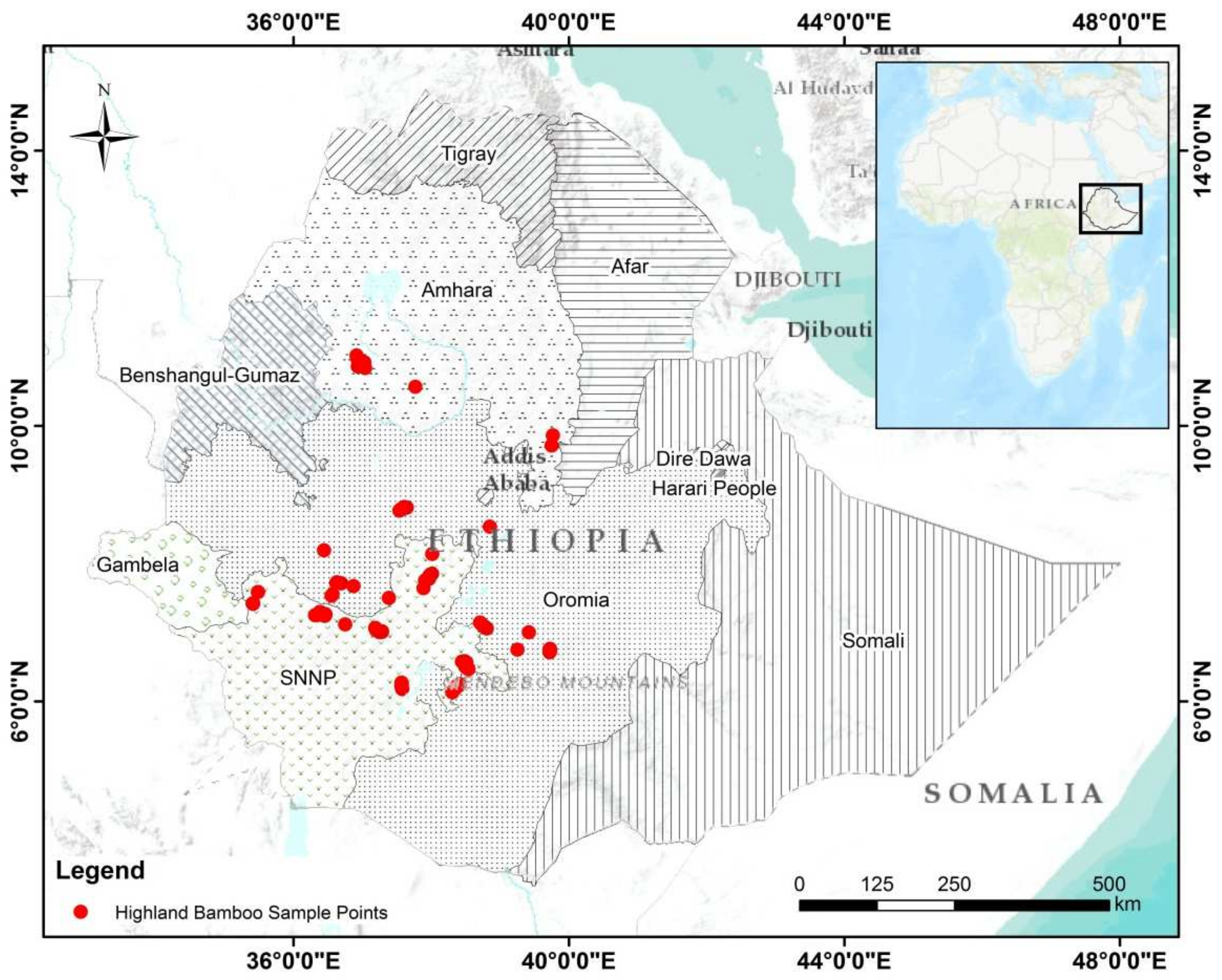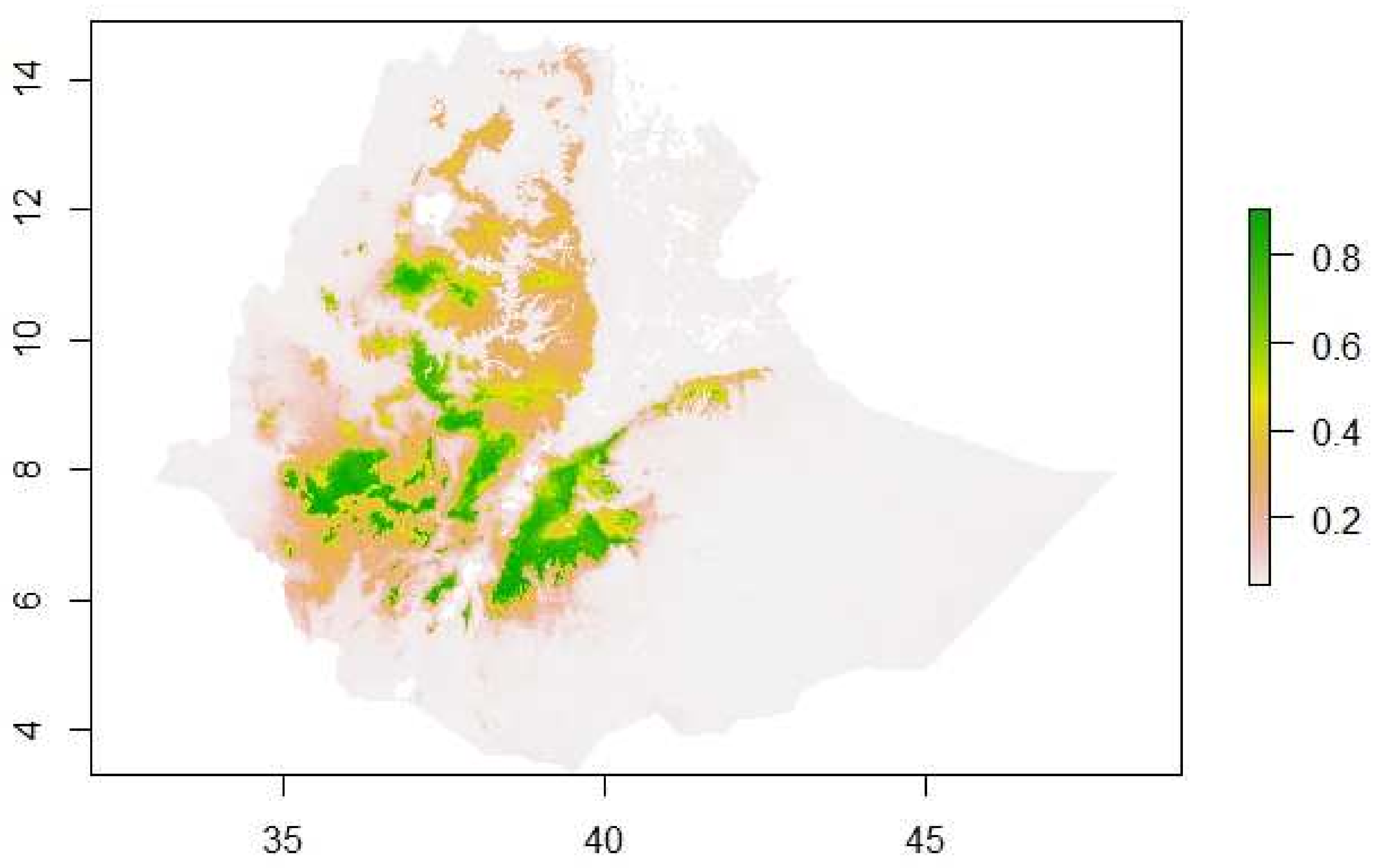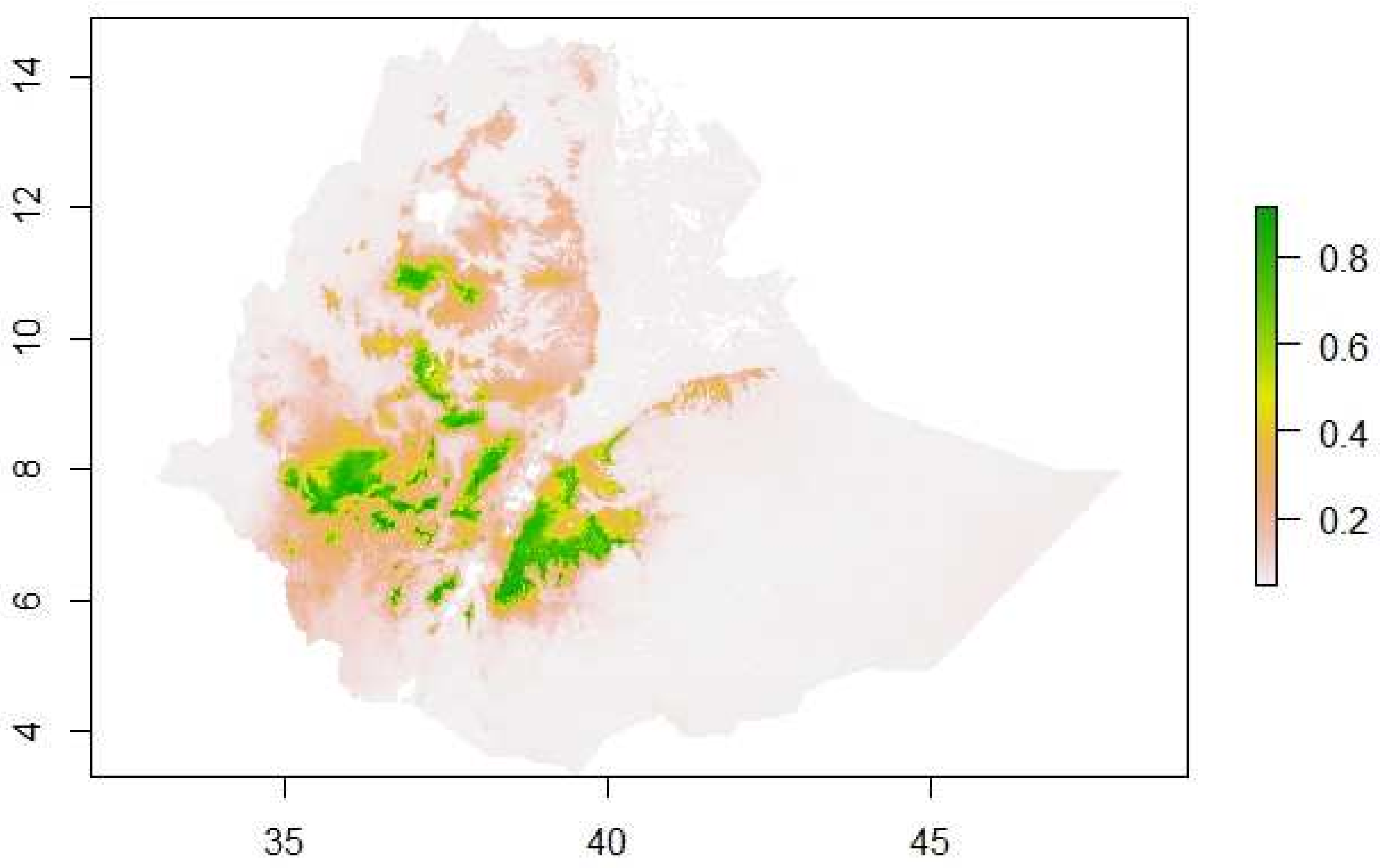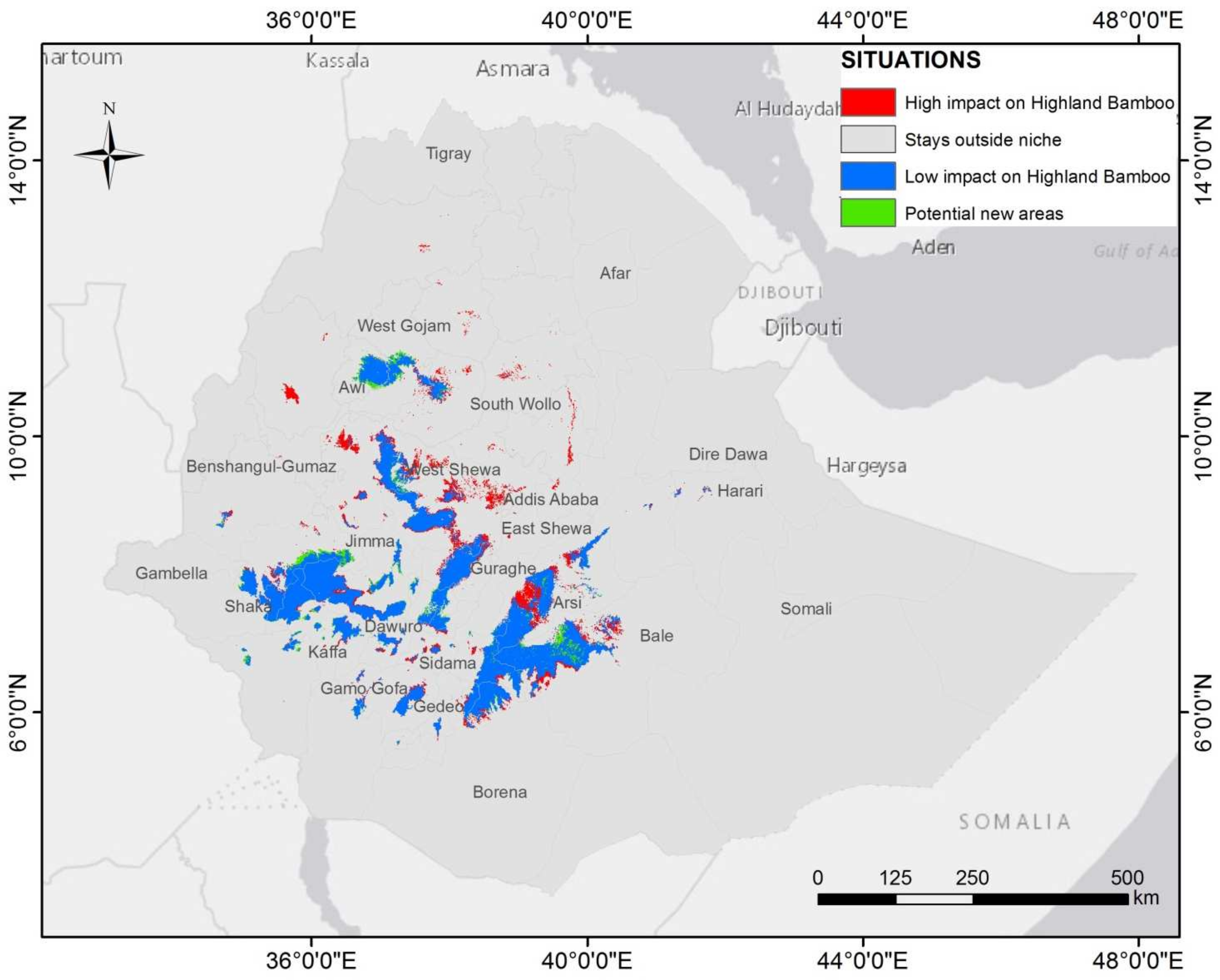Modeling and Mapping Habitat Suitability of Highland Bamboo under Climate Change in Ethiopia
Abstract
1. Introduction
2. Materials and Methods
2.1. Study Area
2.2. Geospatial data
2.2.1. Species Occurrence Data Collection and Processing
2.2.2. Predictor Environmental Variables
2.2.3. Variable Correlation Analysis
2.3. Analysis of Realized Niche
2.4. Distribution Modeling and Model Performance Evaluation
2.5. Spatial Characterization of Highland Bamboo
- High impact areas—areas where a species potentially appears in the present climate but will no longer be suitable in the future;
- Areas outside of the realized niche—areas that are neither suitable under current conditions nor under future conditions;
- Low impact areas—areas where the species can potentially exist in both present and future climates;
- New suitable areas—areas where a species could potentially exist in the future, but which are not suitable for natural occurrence under current conditions.
3. Results
3.1. Correlation between Environmental Variables
3.2. Realized Niche of Highland Bamboo
3.3. Model Performance
3.4. Variable Importance Analysis
3.5. Present and Future Distributions of Highland Bamboo
3.6. Overlay Analysis of Current and Future Potential Distribution Areas
4. Discussion
4.1. Highland Bamboo Niches
4.2. Suitable Habitat for Highland Bamboo under Current Climate Conditions
4.3. Predictions under Different Climate Scenarios and Impact of Climate Change on the Distribution of Highland Bamboo
4.4. Potential Sites for Conservation of Highland Bamboo
5. Conclusions
Supplementary Materials
Author Contributions
Funding
Data Availability Statement
Acknowledgments
Conflicts of Interest
References
- Boko, M.; Niang, I.; Nyong, A.; Vogel, A.; Githeko, A.; Medany, M.; Osman-Elasha, B.; Tabo, R.; Yanda, P.Z. Africa Climate Change 2007: Impacts, Adaptation and Vulnerability; Contribution of Working Group II to the Fourth Assessment Report of the Intergovernmental Panel on Climate Change; Cambridge University Press: Cambridge, UK, 2007. [Google Scholar]
- Sanchez, A.C.; Osborne, P.E.; Haq, N. Climate change and the African baobab (Adansonia digitata L.): The need for better conservation strategies. Afr. J. Ecol. 2011, 49, 234–245. [Google Scholar] [CrossRef]
- Christensen, J.; Hewitson, B.; Busuioc, A.; Chen, A.; Gao, X.; Held, R.; Jones, R.; Kolli, R.; Kwon, W.; Laprise, R. Regional climate projections. In Climate Change, 2007: The Physical Science Basis; Contribution of Working Group I to the Fourth Assessment Report of the Intergovernmental Panel on Climate Change; Cambridge University Press: Cambridge, UK, 2007; pp. 847–940. [Google Scholar]
- Platts, P.J.; Omeny, P.; Marchant, R. AFRICLIM: High-resolution climate projections for ecological applications in Africa. Afr. J. Ecol. 2015, 53, 103–108. [Google Scholar] [CrossRef]
- Conway, D.; Schipper, E.L.F. Adaptation to climate change in Africa: Challenges and opportunities identified from Ethiopia. Glob. Environ. Chang. 2011, 21, 227–237. [Google Scholar] [CrossRef]
- Jury, M.R.; Funk, C. Climatic trends over Ethiopia: Regional signals and drivers. Int. J. Climatol. 2013, 33, 1924–1935. [Google Scholar] [CrossRef]
- McSweeney, C.; New, M.; Lizcano, G. UNDP Climate Change Country Profiles: Ethiopia; United Nations Development Programme: New York, NY, USA, 2010. [Google Scholar]
- Trisos, C.H.; Merow, C.; Pigot, A.L. The projected timing of abrupt ecological disruption from climate change. Nature 2020, 580, 496–501. [Google Scholar] [CrossRef]
- IPCC. Climate Change 2007; Cambridge University Press: Cambridge, UK; New York, NY, USA, 2007. [Google Scholar]
- Malcolm, J.R.; Liu, C.; Neilson, R.P.; Hansen, L.; Hannah, L. Global warming and extinctions of endemic species from biodiversity hotspots. Conserv. Biol. 2006, 20, 538–548. [Google Scholar] [CrossRef] [PubMed]
- McClean, C.J.; Lovett, J.C.; Küper, W.; Hannah, L.; Sommer, J.H.; Barthlott, W.; Termansen, M.; Smith, G.F.; Tokumine, S.; Taplin, J.R. African plant diversity and climate change. Ann. Mo. Bot. Gard. 2005, 92, 139–152. [Google Scholar]
- Cao, B.; Bai, C.; Zhang, L.; Li, G.; Mao, M. Modeling habitat distribution of Cornus officinalis with Maxent modeling and fuzzy logics in China. J. Plant Ecol. 2016, 9, 742–751. [Google Scholar] [CrossRef]
- Mbatudde, M.; Mwanjololo, M.; Kakudidi, E.K.; Dalitz, H. Modelling the potential distribution of endangered Prunus africana (Hook. f.) K alkm. in East Africa. Afr. J. Ecol. 2012, 50, 393–403. [Google Scholar] [CrossRef]
- Scheldeman, X.; Zonneveld, M.V. Training Manual on Spatial Analysis of Plant Diversity and Distribution; Bioversity International: Rome, Italy, 2010. [Google Scholar]
- Elith, J.; Phillips, S.J.; Hastie, T.; Dudík, M.; Chee, Y.E.; Yates, C.J. A statistical explanation of MaxEnt for ecologists. Divers. Distrib. 2011, 17, 43–57. [Google Scholar] [CrossRef]
- Randin, C.F.; Engler, R.; Normand, S.; Zappa, M.; Zimmermann, N.E.; Pearman, P.B.; Vittoz, P.; Thuiller, W.; Guisan, A. Climate change and plant distribution: Local models predict high-elevation persistence. Glob. Chang. Biol. 2009, 15, 1557–1569. [Google Scholar] [CrossRef]
- Gadow, K.v.; Zhang, G.; Durrheim, G.; Drew, D.; Seydack, A. Diversity and production in an Afromontane Forest. For. Ecosyst. 2016, 3, 1–12. [Google Scholar] [CrossRef]
- Grimshaw, J.M. What do we really know about the Afromontane archipelago? Syst. Geogr. Plants 2001, 71, 949–957. [Google Scholar] [CrossRef]
- White, F. The vegetation of Africa. Nat. Resour. Res. 1983, 20, 356. [Google Scholar]
- Friis, I.; Demissew, S.; Breugel, P.v. Atlas of the Potential Vegetation of Ethiopia; Det Kongelige Danske Videnskabernes Selskab: Copenhagen, Denmark, 2010. [Google Scholar]
- Chala, D.; Brochmann, C.; Psomas, A.; Ehrich, D.; Gizaw, A.; Masao, C.A.; Bakkestuen, V.; Zimmermann, N.E. Good-bye to tropical alpine plant giants under warmer climates? Loss of range and genetic diversity in Lobelia rhynchopetalum. Ecol. Evol. 2016, 6, 8931–8941. [Google Scholar] [CrossRef]
- Nogués-Bravo, D.; Araújo, M.B.; Errea, M.; Martinez-Rica, J. Exposure of global mountain systems to climate warming during the 21st Century. Glob. Environ. Chang. 2007, 17, 420–428. [Google Scholar] [CrossRef]
- Hall, J.; Inada, T. Sinarundinaria Alpina (K. Schum.); PROTA (Plant Resources of Tropical Africa): Wageningen, The Netherlands, 2008. [Google Scholar]
- Grimshaw, J.M. The afromontane bamboo, Yushania alpina, on Kilimanjaro. J. East Afr. Nat. Hist. 1999, 88, 79–83. [Google Scholar] [CrossRef]
- Sheil, D.; Ducey, M.; Ssali, F.; Ngubwagye, J.M.; Van Heist, M.; Ezuma, P. Bamboo for people, Mountain gorillas, and golden monkeys: Evaluating harvest and conservation trade-offs and synergies in the Virunga Volcanoes. For. Ecol. Manag. 2012, 267, 163–171. [Google Scholar] [CrossRef]
- Stapleton, C.M. Bergbambos and Oldeania, new genera of African bamboos (Poaceae, Bambusoideae). PhytoKeys 2013, 25, 87–103. [Google Scholar] [CrossRef][Green Version]
- Demissew, S.; Tesfaye, D.; Kassahun, B.; Mehari, A.; Yared, K.; Negash, E.; Sintayehu, E. Mass flowering and death of bamboo: A potential threat to biodiversity and livelihoods in Ethiopia. J. Biodivers. Environ. Sci. 2011, 1, 16–25. [Google Scholar]
- Embaye, K. The indigenous bamboo forests of Ethiopia: An overview. AMBIO A J. Hum. Environ. 2000, 29, 518–521. [Google Scholar] [CrossRef]
- INBAR. Remote Sensing-Based Regional Bamboo Resource Assessment Report of Ethiopia, Kenya and Uganda; International Bamboo and Rattan Organisation: Beijing, China, 2018. [Google Scholar]
- FAO; INBAR. Global Forest Resource Assessment Update, Ethiopia Country Report on Bamboo Resources; FAO: Rome, Italy, 2005. [Google Scholar]
- Zhao, Y.; Feng, D.; Jayaraman, D.; Belay, D.; Sebrala, H.; Ngugi, J.; Maina, E.; Akombo, R.; Otuoma, J.; Mutyaba, J. Bamboo mapping of Ethiopia, Kenya and Uganda for the year 2016 using multi-temporal Landsat imagery. Int. J. Appl. Earth Obs. Geoinf. 2018, 66, 116–125. [Google Scholar] [CrossRef]
- Boria, R.A.; Olson, L.E.; Goodman, S.M.; Anderson, R.P. Spatial filtering to reduce sampling bias can improve the performance of ecological niche models. Ecol. Model. 2014, 275, 73–77. [Google Scholar] [CrossRef]
- Brown, J.L.; Bennett, J.R.; French, C.M. SDMtoolbox 2.0: The next generation Python-based GIS toolkit for landscape genetic, biogeographic and species distribution model analyses. PeerJ 2017, 5, e4095. [Google Scholar] [CrossRef] [PubMed]
- ESRI. ArcGIS Desktop 10.3; Environmental Systems Research Institute: Redlands, CA, USA, 2014. [Google Scholar]
- Fick, S.E.; Hijmans, R.J. WorldClim 2: New 1-km spatial resolution climate surfaces for global land areas. Int. J. Climatol. 2017, 37, 4302–4315. [Google Scholar] [CrossRef]
- Hijmans, R.J.; Cameron, S.E.; Parra, J.L.; Jones, P.G.; Jarvis, A. Very high resolution interpolated climate surfaces for global land areas. Int. J. Climatol. A J. R. Meteorol. Soc. 2005, 25, 1965–1978. [Google Scholar] [CrossRef]
- Bobrowski, M.; Weidinger, J.; Schickhoff, U. Is new always better? frontiers in global climate datasets for modeling treeline species in the Himalayas. Atmosphere 2021, 12, 543. [Google Scholar] [CrossRef]
- Young, N.; Carter, L.; Evangelista, P. A MaxEnt Model v3. 3.3 e Tutorial (ArcGIS v10); Natural Resource Ecology Laboratory, Colorado State University and the National Institute of Invasive Species Science: Fort Collins, CO, USA, 2011. [Google Scholar]
- Williams, K.; Copsey, D.; Blockley, E.; Bodas-Salcedo, A.; Calvert, D.; Comer, R.; Davis, P.; Graham, T.; Hewitt, H.; Hill, R. The Met Office global coupled model 3.0 and 3.1 (GC3. 0 and GC3. 1) configurations. J. Adv. Model. Earth Syst. 2018, 10, 357–380. [Google Scholar] [CrossRef]
- Kelley, M.; Schmidt, G.A.; Nazarenko, L.S.; Bauer, S.E.; Ruedy, R.; Russell, G.L.; Ackerman, A.S.; Aleinov, I.; Bauer, M.; Bleck, R. GISS-E2. 1: Configurations and climatology. J. Adv. Model. Earth Syst. 2020, 12, e2019MS002025. [Google Scholar] [CrossRef]
- Lovato, T.; Peano, D.; Butenschön, M.; Materia, S.; Iovino, D.; Scoccimarro, E.; Fogli, P.; Cherchi, A.; Bellucci, A.; Gualdi, S. CMIP6 Simulations With the CMCC Earth System Model (CMCC-ESM2). J. Adv. Model. Earth Syst. 2022, 14, e2021MS002814. [Google Scholar] [CrossRef]
- Eyring, V.; Bony, S.; Meehl, G.A.; Senior, C.A.; Stevens, B.; Stouffer, R.J.; Taylor, K.E. Overview of the Coupled Model Intercomparison Project Phase 6 (CMIP6) experimental design and organization. Geosci. Model Dev. 2016, 9, 1937–1958. [Google Scholar] [CrossRef]
- Jury, M.R. Statistical evaluation of CMIP5 climate change model simulations for the Ethiopian highlands. Int. J. Climatol. 2015, 35, 37–44. [Google Scholar] [CrossRef]
- Koch, O.; Mengesha, W.A.; Pironon, S.; Pagella, T.; Ondo, I.; Rosa, I.; Wilkin, P.; Borrell, J.S. Modelling potential range expansion of an underutilised food security crop in Sub-Saharan Africa. Environ. Res. Lett. 2021, 17, 014022. [Google Scholar] [CrossRef]
- Legesse, S.A. The outlook of Ethiopian long rain season from the global circulation model. Environ. Syst. Res. 2016, 5, 1–16. [Google Scholar] [CrossRef]
- Sanderson, B.M.; Knutti, R.; Caldwell, P. A representative democracy to reduce interdependency in a multimodel ensemble. J. Clim. 2015, 28, 5171–5194. [Google Scholar] [CrossRef]
- Moss, R.H.; Edmonds, J.A.; Hibbard, K.A.; Manning, M.R.; Rose, S.K.; Van Vuuren, D.P.; Carter, T.R.; Emori, S.; Kainuma, M.; Kram, T. The next generation of scenarios for climate change research and assessment. Nat. Plants 2010, 463, 747–756. [Google Scholar] [CrossRef]
- Rogelj, J.; Meinshausen, M.; Knutti, R. Global warming under old and new scenarios using IPCC climate sensitivity range estimates. Nat. Clim. Chang. 2012, 2, 248–253. [Google Scholar] [CrossRef]
- Eshetae, M.A.; Hailu, B.T.; Demissew, S. Spatial characterization and distribution modelling of Ensete ventricosum (wild and cultivated) in Ethiopia. Geocarto Int. 2021, 36, 60–75. [Google Scholar] [CrossRef]
- Gebrewahid, Y.; Abrehe, S.; Meresa, E.; Eyasu, G.; Abay, K.; Gebreab, G.; Kidanemariam, K.; Adissu, G.; Abreha, G.; Darcha, G. Current and future predicting potential areas of Oxytenanthera abyssinica (A. Richard) using MaxEnt model under climate change in Northern Ethiopia. Ecol. Processes 2020, 9, 1–15. [Google Scholar] [CrossRef]
- Naimi, B.; Hamm, N.A.; Groen, T.A.; Skidmore, A.K.; Toxopeus, A.G. Where is positional uncertainty a problem for species distribution modelling? Ecography 2014, 37, 191–203. [Google Scholar] [CrossRef]
- Guisan, A.; Thuiller, W.; Zimmermann, N.E. Habitat Suitability and Distribution Models: With Applications in R; Cambridge University Press: Cambridge, UK, 2017. [Google Scholar]
- Kosicki, J.Z. Generalised Additive Models and Random Forest Approach as effective methods for predictive species density and functional species richness. Environ. Ecol. Stat. 2020, 27, 273–292. [Google Scholar] [CrossRef]
- Valavi, R.; Elith, J.; Lahoz-Monfort, J.J.; Guillera-Arroita, G. Modelling species presence-only data with random forests. Ecography 2021, 44, 1731–1742. [Google Scholar] [CrossRef]
- Allouche, O.; Tsoar, A.; Kadmon, R. Assessing the accuracy of species distribution models: Prevalence, kappa and the true skill statistic (TSS). J. Appl. Ecol. 2006, 43, 1223–1232. [Google Scholar] [CrossRef]
- Zhang, L.; Liu, S.; Sun, P.; Wang, T.; Wang, G.; Zhang, X.; Wang, L. Consensus forecasting of species distributions: The effects of niche model performance and niche properties. PLoS ONE 2015, 10, e0120056. [Google Scholar] [CrossRef] [PubMed]
- Naimi, B.; Araújo, M.B. sdm: A reproducible and extensible R platform for species distribution modelling. Ecography 2016, 39, 368–375. [Google Scholar] [CrossRef]
- Ahmed, N.; Atzberger, C.; Zewdie, W. Species Distribution Modelling performance and its implication for Sentinel-2-based prediction of invasive Prosopis juliflora in lower Awash River basin, Ethiopia. Ecol. Processes 2021, 10, 1–16. [Google Scholar] [CrossRef]
- Moat, J.; Williams, J.; Baena, S.; Wilkinson, T.; Gole, T.W.; Challa, Z.K.; Demissew, S.; Davis, A.P. Resilience potential of the Ethiopian coffee sector under climate change. Nat. Plants 2017, 3, 1–14. [Google Scholar] [CrossRef]
- Abrha, H.; Birhane, E.; Hagos, H.; Manaye, A. Predicting suitable habitats of endangered Juniperus procera tree under climate change in Northern Ethiopia. J. Sustain. For. 2018, 37, 842–853. [Google Scholar] [CrossRef]
- Breugel, V.; Friis, I.; Demissew, S. The transitional semi-evergreen bushland in Ethiopia: Characterization and mapping of its distribution using predictive modelling. Appl. Veg. Sci. 2016, 19, 355–367. [Google Scholar] [CrossRef]
- Girma, A.; de Bie, C.; Skidmore, A.K.; Venus, V.; Bongers, F. Hyper-temporal SPOT-NDVI dataset parameterization captures species distributions. Int. J. Geogr. Inf. Sci. 2016, 30, 89–107. [Google Scholar] [CrossRef]
- Hailu, B.T.; Maeda, E.E.; Pellikka, P.; Pfeifer, M. Identifying potential areas of understorey coffee in Ethiopia’s highlands using predictive modelling. Int. J. Remote Sens. 2015, 36, 2898–2919. [Google Scholar] [CrossRef]
- Peterson, A.T.; Soberón, J.; Pearson, R.G.; Anderson, R.P.; Martínez-Meyer, E.; Nakamura, M.; Araújo, M.B. Ecological Niches and Geographic Distributions; Princeton University Press: Princeton, NJ, USA, 2011. [Google Scholar]
- Bekele-Tesemma, A.; Tengnäs, B. Useful Trees and Shrubs of Ethiopia: Identification, Propagation, and Management for 17 Agroclimatic Zones; RELMA in ICRAF Project, World Agroforestry Centre, Eastern Africa Region: Nairobi, Kenya, 2007. [Google Scholar]
- Phillips, S. Flora of Ethiopia and Eritrea, Poacea (Gramineae); The National Herbarium, Addis Ababa Uniiversity: Addis Ababa, Ethiopia, 1995; Volume 7. [Google Scholar]
- Desalegn, G.; Tadesse, W. Resource Communication. Resource potential of bamboo, challenges and future directions towards sustainable management and utilization in Ethiopia. For. Syst. 2014, 23, 294–299. [Google Scholar]
- Kelbessa, E.; Bekele, T.; Gebrehiwot, A.; Hadera, G.; Ababa, A. A Socioeconomic Case Study of the Bamboo Sector in Ethiopia; International Bamboo and Rattan Organisation: Beijing, China, 2000. [Google Scholar]
- Davis, A.P.; Gole, T.W.; Baena, S.; Moat, J. The impact of climate change on indigenous arabica coffee (Coffea arabica): Predicting future trends and identifying priorities. PLoS ONE 2012, 7, e47981. [Google Scholar] [CrossRef] [PubMed]
- Song, X.-z.; Peng, C.-h.; Zhou, G.-m.; Jiang, H.; Wang, W.-f.; Xiang, W.-h. Climate warming-induced upward shift of Moso bamboo population on Tianmu Mountain, China. J. Mt. Sci. 2013, 10, 363–369. [Google Scholar] [CrossRef]
- Lynch, M.; Lande, R. Evolution and extinction in response to environ mental change. In Biotic Interactions and Global Change; Huey, R., Kareiva, P., Kingsolver, J., Eds.; Sinauer Associates: Sunderland, MA, USA, 1993; pp. 234–250. [Google Scholar]







| Code | Environmental Variable | Mean | Minimum | Maximum |
|---|---|---|---|---|
| Bio_1 | Annual mean temperature | 14.81 | 11.54 | 19.33 |
| Bio_2 | Mean diurnal range | 13.07 | 11.09 | 15.61 |
| Bio_3 | Isothermality | 80.57 | 75.25 | 86.19 |
| Bio_4 | Temperature seasonality | 93.76 | 49.78 | 134.35 |
| Bio_5 | Max temperature of warmest month | 22.46 | 18.90 | 27.50 |
| Bio_6 | Min temperature of coldest month | 6.22 | 3.60 | 9.80 |
| Bio_7 | Temperature annual rang | 16.24 | 13.50 | 18.60 |
| Bio_8 | Mean temperature of wettest quarter | 14.10 | 10.95 | 18.60 |
| Bio_9 | Mean temperature of driest quarter | 15.00 | 11.57 | 20.65 |
| Bio_10 | Mean temperature of warmest quarter | 15.97 | 12.05 | 20.93 |
| Bio_11 | Mean temperature of coldest quarter | 13.71 | 10.57 | 18.50 |
| Bio_12 | Annual precipitation | 1443.89 | 873.00 | 1962.00 |
| Bio_13 | Precipitation of wettest month | 237.68 | 136.00 | 429.00 |
| Bio_14 | Precipitation of driest month | 22.93 | 6.00 | 39.00 |
| Bio_15 | Precipitation seasonality | 63.73 | 46.35 | 114.47 |
| Bio_16 | Precipitation of wettest quarter | 635.36 | 364.00 | 1094.00 |
| Bio_17 | Precipitation of driest quarter | 91.40 | 36.00 | 147.00 |
| Bio_18 | Precipitation of warmest quarter | 286.57 | 139.00 | 496.00 |
| Bio_19 | Precipitation of coldest quarter | 518.21 | 41.00 | 1089.00 |
| Elevation | Elevation (m) | 2539 | 2095 | 3097 |
| Slope | Slope (%) | 4 | 0 | 16 |
| Aspect | Aspect (degree) | 197 | 5 | 357 |
| Soil_pH | Soil pH | 5.6 | 5 | 6.6 |
| Soil_cec | Soil Cation Exchange Capacity (cmolc/kg) | 30.7 | 22 | 47 |
| Soil_tex | Soil texture | - | - | - |
| Methods | AUC | TSS | Kappa | COR | Deviance |
|---|---|---|---|---|---|
| GLM | 0.97 | 0.89 | 0.84 | 0.88 | 0.78 |
| MAXENT | 0.99 | 0.95 | 0.91 | 0.92 | 0.53 |
| BRT | 0.99 | 0.94 | 0.91 | 0.92 | 0.59 |
| RF | 0.99 | 0.94 | 0.92 | 0.93 | 0.24 |
| SVM | 0.98 | 0.93 | 0.91 | 0.92 | 0.32 |
| MARS | 0.96 | 0.90 | 0.84 | 0.87 | 3.48 |
| Ensemble | 1.00 | 0.96 | 0.96 | 0.95 | 0.36 |
| Situations | Amount of Land (km2) | |
|---|---|---|
| SSP2-45 | SSP5-85 | |
| High Impact on Highland Bamboo | 4862.01 | 11,727.55 |
| Low Impact on Highland Bamboo | 55,402.19 | 48,537.52 |
| Potential New Suitable Areas | 15,208.97 | 3617.83 |
| Areas Outside of the Realized Niche | 1,057,786.06 | 1,069,377.20 |
Publisher’s Note: MDPI stays neutral with regard to jurisdictional claims in published maps and institutional affiliations. |
© 2022 by the authors. Licensee MDPI, Basel, Switzerland. This article is an open access article distributed under the terms and conditions of the Creative Commons Attribution (CC BY) license (https://creativecommons.org/licenses/by/4.0/).
Share and Cite
Yebeyen, D.; Nemomissa, S.; Hailu, B.T.; Zewdie, W.; Sileshi, G.W.; Rodríguez, R.L.; Woldie, T.M. Modeling and Mapping Habitat Suitability of Highland Bamboo under Climate Change in Ethiopia. Forests 2022, 13, 859. https://doi.org/10.3390/f13060859
Yebeyen D, Nemomissa S, Hailu BT, Zewdie W, Sileshi GW, Rodríguez RL, Woldie TM. Modeling and Mapping Habitat Suitability of Highland Bamboo under Climate Change in Ethiopia. Forests. 2022; 13(6):859. https://doi.org/10.3390/f13060859
Chicago/Turabian StyleYebeyen, Dagnew, Sileshi Nemomissa, Binyam Tesfaw Hailu, Worku Zewdie, Gudeta W. Sileshi, Rosana López Rodríguez, and Tefera M. Woldie. 2022. "Modeling and Mapping Habitat Suitability of Highland Bamboo under Climate Change in Ethiopia" Forests 13, no. 6: 859. https://doi.org/10.3390/f13060859
APA StyleYebeyen, D., Nemomissa, S., Hailu, B. T., Zewdie, W., Sileshi, G. W., Rodríguez, R. L., & Woldie, T. M. (2022). Modeling and Mapping Habitat Suitability of Highland Bamboo under Climate Change in Ethiopia. Forests, 13(6), 859. https://doi.org/10.3390/f13060859









